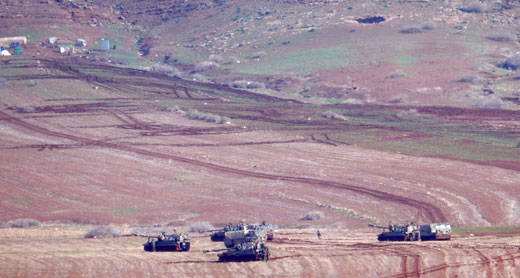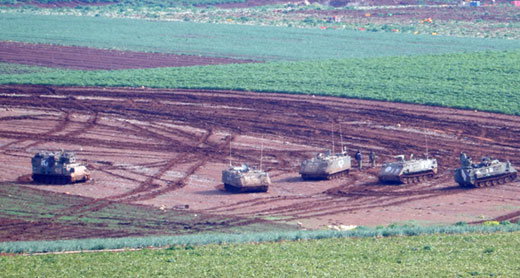Israeli military trains, fires shells near homes of Kh. a-Ras al-Ahmar, northern Jordan Valley
Published:
9 Feb 2016
In mid-January 2016, Civil Administration (CA) officials notified 24 Palestinian families in two northern Jordan Valley communities that they would have to vacate their homes for many hours at the end of the month, as the military ostensibly needed to conduct training in the area. The residents under evacuation orders were ten families from Khirbet a-Ras al-Ahmar, which lies east of the town of Tammun. The community numbers 120 members, about half of them minors. Some residents of the community were temporarily displaced eight times during 2015, for the same alleged reason. Fourteen families from Ibziq, located near Tubas and numbering 250 members, almost half of them minors, were also told to temporarily vacate their homes. Some families in the community live at the site only part of the year. Residents of this community were also temporarily displaced eight times during 2015, for the same alleged reason. These repeated displacements forced the families, including youngsters, to leave their homes on short notice for extended periods of time and remain without adequate shelter in severe weather conditions.

Military tanks in fields cultivated by the community, partially seen in the top-left corner. Photo by ‘Aref Daraghmeh, B'Tselem, 27 Jan. 2016
This time, due to extreme cold and strong winds on the scheduled dates, the military informed the communities via the Palestinian DCO that they would not be required to leave their homes, but that the training would go ahead as planned. According to B'Tselem’s documentation, on Wednesday, 27 January 2016, a significant military force including tanks and other vehicles arrived at farmland belonging to Khirbet a-Ras al-Ahmar. Part of the force positioned itself only some 100 meters away from community dwellings and fired into the distance. The shelling so close to the tents caused panic in the community, particularly among the children. Residents also feared the military would leave duds close to the tents and that the shooting would start fires in nearby fields, as had been the case in previous training sessions conducted in the area. After the training ended, members of the community told B'Tselem that the tanks and other vehicles had caused severe damage to their crops by driving over them.
In a testimony given on 1 Feb., Lutfi Bani ‘Odeh, who lives with his wife and 11 children in the community, told B'Tselem field-researcher ‘Aref Daraghmeh what happened that day:
We got orders to vacate our homes on 26 and 27 January. The military had decided to evacuate families in western Khirbet a-Ras al-Ahmar, but because of the severe weather, the Palestinian DCO and various organizations intervened and the evacuation was called off. Despite this, soldiers parked their tanks close to our homes and did not let us access the grazing pastures nearby. Dozens of tanks fired near our houses and our neighbors’ houses. The noise was deafening. Our children really panicked, and we were afraid we’d get hit by a shell. The minutes passing felt like eternity. There were dozens of tanks and hundreds of soldiers here. They damaged the land and ruined everything. They destroyed the road that leads to the community, too.
It was like a war. They fired shells everywhere and destroyed the area. We’re still afraid of the duds they left behind. It’s scary, especially in the fields, where you can’t see the duds, and touching them can be lethal. We’re especially worried about the children, because they don’t know how to identify the duds and keep away from them. The military trains all over the place here. They want to push us out of our land. This is our land. We have no other source of income except herding. We live here so we can feed our children. We want to live in peace.
Israel’s policy in the Jordan Valley turns vast areas into military training fields and the Palestinians living there into unwilling extras on this set. As the occupying power in the West Bank, Israel may not use the occupied territory for general military purposes, such as training for war or routine military training. Displacing residents to make way for training also defies international humanitarian law, which allows the occupying power to take action in the occupied territory for two reasons only – to benefit the local population, or to meet imperative military needs connected to the operations in the occupied territory.
Additionally, training grounds are selectively chosen. Training never takes place close to settlements in the Jordan Valley or to lands that have been transferred to their control, nor in a manner that might put settlers in danger or disrupt their lives. Settlers have never been forced to vacate their homes to allow the military to train. No official has ever explained how training grounds are chosen, but the apparent selectiveness uncovers the motivation behind it – dispossession.
 Military tanks in fields cultivated by the community. Photo by ‘Aref Daraghmeh, B'Tselem, 27 Jan. 2016
Military tanks in fields cultivated by the community. Photo by ‘Aref Daraghmeh, B'Tselem, 27 Jan. 2016
An examination of Israel’s policy in the Jordan Valley over the years shows that military training and closed military zone orders have been systematically used as part of a policy to harass residents of Jordan Valley communities and make their lives in the area difficult, in an effort to reduce Palestinian presence in Area C.
Israel must immediately cease use of the occupied Jordan Valley as a military training ground, including forced temporary displacements of communities for this purpose and all other measures taken in an attempt to force Palestinian residents of the Jordan Valley out of the area.

هیچ نظری موجود نیست:
ارسال یک نظر